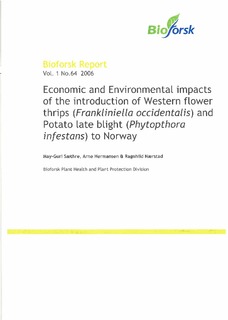| dc.contributor.author | Sæthre, May | |
| dc.contributor.author | Hermansen, Arne | |
| dc.contributor.author | Nærstad, Ragnhild | |
| dc.coverage.spatial | Norway, Akershus, Ås | nb_NO |
| dc.date.accessioned | 2018-07-14T20:21:04Z | |
| dc.date.available | 2018-07-14T20:21:04Z | |
| dc.date.created | 2018-06-29T16:47:17Z | |
| dc.date.issued | 2006-05-02 | |
| dc.identifier.isbn | 978-82-17-00057-0 | |
| dc.identifier.uri | http://hdl.handle.net/11250/2505498 | |
| dc.description.abstract | The western flower thrips, Frankliniella occidentalis (Pergande), is a highly polyphagous species with a host range including over 250 species of herbaceous and woody plants belonging to 62 families. F. occidentalis originates in western USA but has spread, since 1970, into many countries in Asia, Africa, Central and South America, Europe and Oceania. In southern regions of Europe the pest is found outdoors attacking the flowers of a number of host plants. In northern European countries it is a pest mainly in protected crops (i.e. glasshouses) attacking a number of ornamentals and vegetables. F. occidentalis is a vector of Tomato spotted wilt virus (TSWV) and several other viruses. Both these organisms are regulated as quarantine pests in the EPPO region (European and Mediterranean Plant Protection Organization). The first report of F. occidentalis in Norway was in 1986 and it spread very quickly within greenhouse environments. In 1987 the species was added to the A-list (quarantine pests with zero-tolerance on import to Norway) and a comprehensive spraying program to eradicate the introduced pest and stop further spread was developed. The thrips, however, continued to spread and in 1991 about 40% of all greenhouses in Norway were infested with F. occidentalis. A plan of action (Trips-aksjonen) to combat and eradicate F. occidentalis from Norway was executed in 1991. In spite of extensive efforts by growers and authorities they did not succeed in eradicating or stopping further spread of F. occidentalis. In 1997 the species was considered established in Norwegian greenhouses and it was therefore deleted from the Norwegian A-list. It is now under surveillance as a vector for TSWV (an A-list pest) and is treated as a quarantine pest if discovered in connection with TSWV. The introduction and establishment of F. occidentalis in Norwegian greenhouses has been a burden to both growers and the society. Growers have suffered financial losses in terms of costs of carrying out comprehensive quarantine instructions (1986-1996) as well as through direct crop loss and costs of control measures (1986-2006). Indirect economic impacts of F. occidentalis include the implications for growers due to the quarantine instructions (1987- 1996) such as increased labour to carry out the instructions; cost of pesticides; loss of production time during the quarantine and eradication period; loss of contracts when not able to deliver plants and seedlings on time; loss of reputation; and perhaps as a combination of the others also loss of future contracts. Growers have also suffered in terms of health risks as they have used pesticides more frequently and thereby been exposed to pesticides more often. Very rough estimates and assessments to predict potential crop loss caused by F. occidentalis suggests a worst case scenario (or 100% crop loss) to be about 1454.4 mill NOK per year (2003-numbers). Assuming that the proportion of infested greenhouses at any given time during the year is somewhere between 30-40%, then potential crop losses would be between 436-582 mill NOK per year. It should be underlined that these numbers are rough estimates only, not accurate measurements. Introduction/establishment of the species has resulted in an increased effort from extension service, phytosanitary authorities, and scientists, the costs involved are, however, difficult to assess. […] | nb_NO |
| dc.description.abstract | Economic and Environmental impacts of the introduction of Western flower thrips (Fvankliniella occidentalis) and Potato late blight (Phytopthova infestans) to Norway | nb_NO |
| dc.language.iso | eng | nb_NO |
| dc.publisher | Bioforsk Plantehelse | nb_NO |
| dc.relation.ispartof | Bioforsk Rapport | |
| dc.relation.ispartofseries | Bioforsk rapport;1(64) 2006 | |
| dc.subject | Ikke hjemmehørende arter | nb_NO |
| dc.subject | Non-indigenous species | nb_NO |
| dc.title | Economic and Environmental impacts of the introduction of Western flower thrips (Fvankliniella occidentalis) and Potato late blight (Phytopthova infestans) to Norway | nb_NO |
| dc.type | Research report | nb_NO |
| dc.description.version | publishedVersion | nb_NO |
| dc.subject.nsi | VDP::Planteforedling, hagebruk, plantevern, plantepatologi: 911 | nb_NO |
| dc.subject.nsi | VDP::Plant breeding, horticulture, plant protection, plant pathology: 911 | nb_NO |
| dc.source.pagenumber | 35 | nb_NO |
| dc.source.volume | 1 | nb_NO |
| dc.source.issue | 64 | nb_NO |
| dc.identifier.cristin | 1594895 | |
| dc.relation.project | Bioforsk: 1110341 | nb_NO |
| cristin.ispublished | true | |
| cristin.fulltext | original | |
